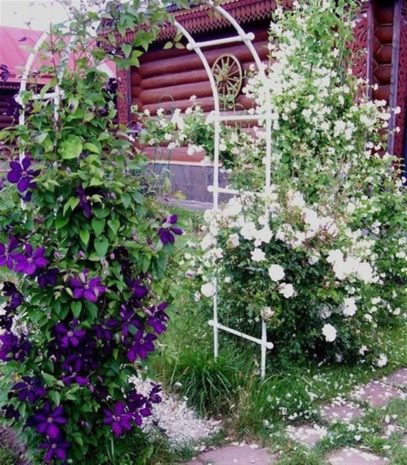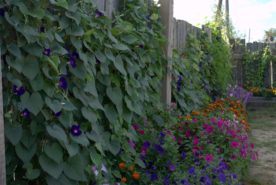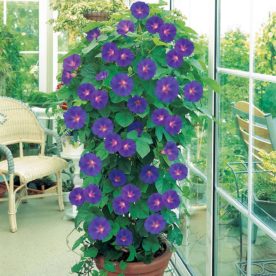Of all garden vines, the fastest growing is considered to be a bindweed. It grows well on both horizontal and vertical surfaces. Bright greens and amazingly flexible shoots allow you to create unique compositions on personal plots. In nature, both annual and perennial plants are found, and the most common species is field bindweed, which affects crops and vegetable gardens.
Material Content:
Botanical Description
Bindweed is a herbaceous plant and belongs to the family of bindweed.

- Has a branched root system, which is able to penetrate up to 2 meters.
- The stalk is thin, creeping, can twist around various obstacles, as it reaches a length of up to 3 meters.
- Leaves are single, formed on long cuttings and have an elongated ovoid shape. As a rule, their length is 3 times greater than the width.
- The flowers are quite large bell-shaped.
A related species of this plant is considered to be a field birch, the flowers of which are slightly smaller. Bindweed blooms in the period from July to September, each flower opens for only a few hours. About this happens from 7 a.m. and 2 p.m.
It is growing everywhere, it can be found in all CIS countries. Prefers loamy and sandy loamy soils. You can often hear that the plant is called a weed, as it can spread through garbage places, and abandoned gardens, and forest glades.
Due to the long roots, the bindweed is difficult to destroy, not even all chemicals can cope with it. After weeding, it grows again, because it can develop even from the smallest remnant of the root system.
Species, varieties and names of plants
To date, several varieties of field bindweed are known.

Among gardeners, the following are popular:
- Moorish bindweed. A great option for vertical space design. In most cases, it is grown in containers and pots. Its shoots are covered with soft green leaves, the length of which reaches up to 50 centimeters. During flowering, pleases with flowers of a light lilac hue.
- Bindweed is two-peaked. The countries of Asia, Siberia and the Caucasus are considered his homeland. Due to its characteristics, it spreads on the arid slopes of the mountains, in mountain steppes and along sandy shores. Its slightly curly stems reach a length of 30 - 40 centimeters. The leaves of the plant are arrow-shaped, up to 7 cm, single pink flowers. This species belongs to the "wild" and gardeners used relatively recently.
- Three-colored bindweed is one of the most prominent representatives, which is famous for its densely branched structure. An annual plant, in height reaches about 50 centimeters. The plant consists of thin and flexible shoots on which oval-shaped leaves are densely located. The flowers have the shape of a funnel with a diameter of about 4 cm. But due to the bright and colorful color, they can seem much larger. The plant got its name thanks to three shades on the inflorescences. The blue hue at the edges smoothly turns into white, and then harmoniously merges with the lemon core. Bindweed blooms from early June to early autumn. It can spread by self-sowing and at the same time has a good yield. This species is represented by several varieties: “Krimzon Monarch”, “Blue Flash”, “Royal Ensin”.
Please note that the star bindweed, which is also called the "Spanish flag" or "Ipomoea Mina Lobata", is a liana, but it has nothing to do with the kind of Bindweed.
Features of growing bindweed
According to its requirements for growing bindweed, it is similar to other garden vines. This non-whimsical plant is able to be content with a small one, and thanks to its abundant flowering it surprises even experienced gardeners. Solar location or scattered lighting with non-acidic soil guarantee success in growing any kind of bindweed.
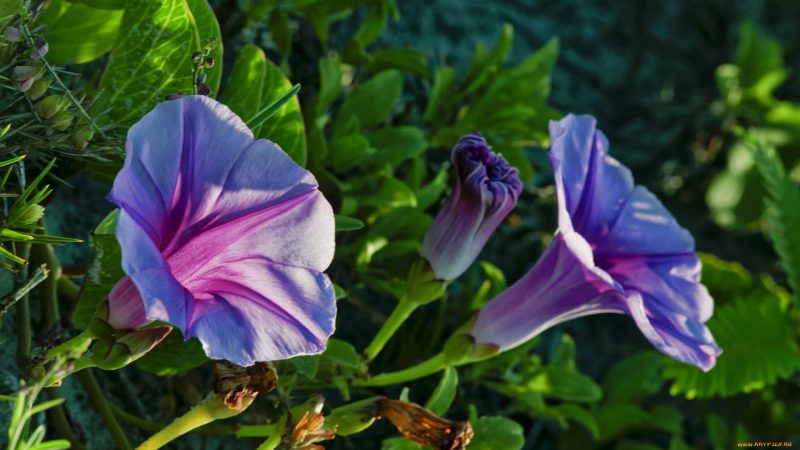
The maximum effect in flowering is manifested in sunny areas with high quality loams. But on the other hand, the plant is not demanding on special conditions and is able to take root in almost any kind of garden soil.
Outdoor landing
As practice shows, bindweed can grow in any soil.
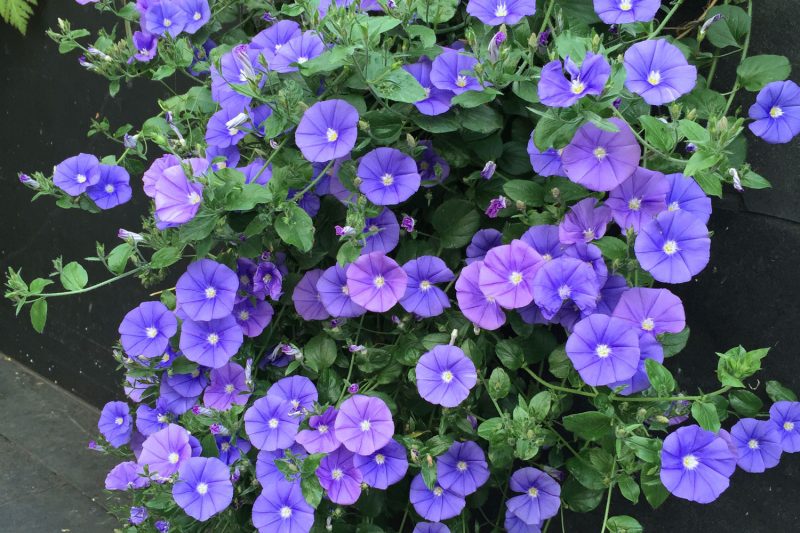
But if there is a desire to get a long and plentiful flowering, then the following rules should be considered:
- best plant survives on non-acidic soils;
- before planting, the earth must be loosened, as well as combined with peat and sand;
- You can additionally make mineral or organic fertilizers.
Growing bindweed in the open ground consists of several stages:
- Seeds intended for planting are pre-soaked in water.
- Before planting, it is recommended to add decomposed peat to the soil, it will accompany the rapid germination of seeds.
- Grooves are made in loose soil at a distance of 25-50 centimeters from each other.
- After landing in the ground, seeds need abundant watering.
- If there is a chance of frost, then the beds with seeds need to be covered, the film is removed immediately after stable warm weather is established.
- When the sprouts appear, you need to carry out moderate watering.
- As you grow, do not forget to thin out the plant so that it pleases with its strength and abundant flowering.
Seeds should be sown in mid-April - early May. For earlier flowering, you can grow bindweed seedlings.
How to care for a bindweed
Plant care is minimal, as it is able to cope even with the most extreme conditions in the hot summer months. Despite the fact that watering is not the main condition for leaving, nevertheless timely application of water will allow to achieve abundant lush flowering.
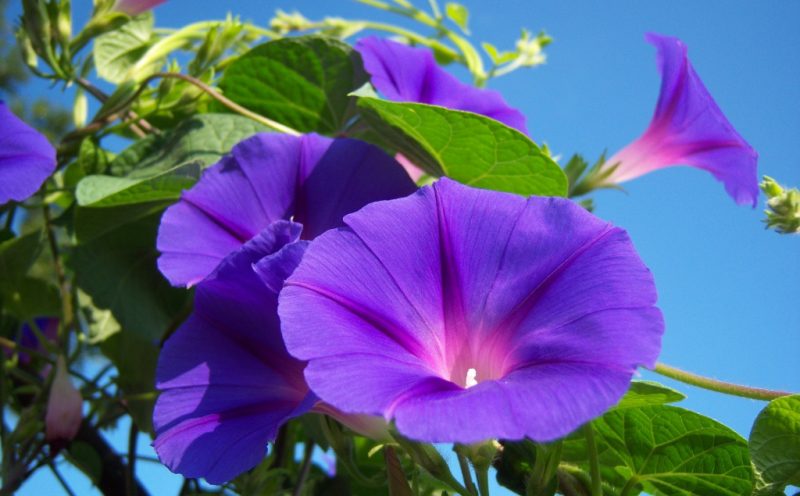
Weeding is done only after planting. You do not need to remove wilted flowers and feed the plant.When growing on supports, weaving stems should be guided, which will allow you to form a beautiful composition.
Feeding is recommended only to those plants that are grown in containers.
Protection against diseases and pests
Bindweed flower is one of the most resistant to diseases and pests.
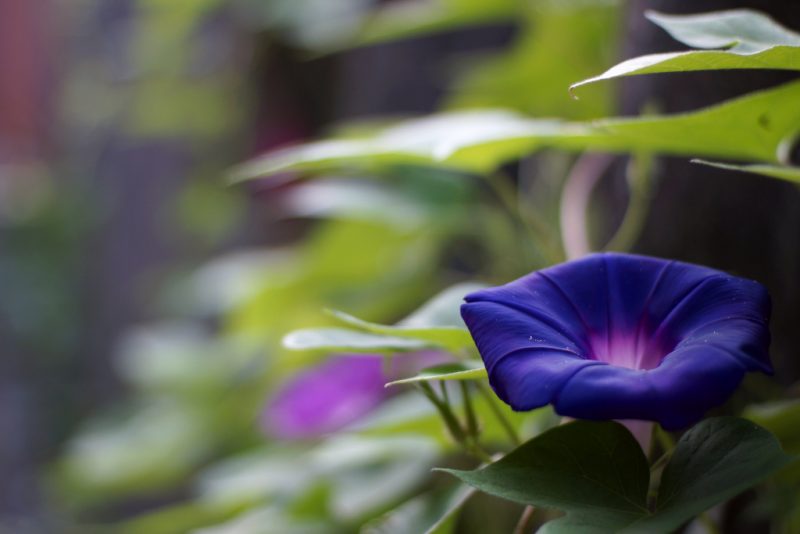
- In rare cases, it can be affected by powdery mildew, which manifests itself in the form of a white coating on different parts of the plant. This fungal disease occurs as a result of heavy watering, poor thinning, shading. To get rid of the disease, you need to eliminate the affected parts of the plant. In addition, the bindweed, as well as the ground under it, is sprayed with a fungicide.
- Yellowing leaves with black dots on the inside indicate a spider mite lesion. Affected parts of the plant must be removed and burned. The rest is treated with a special drug.
Exotic liana in landscape design
Today, bindweed are actively used in landscaping. It allows you to effectively hide empty spaces and crevices, decorate slopes, as well as draw out areas unsuitable for other plants. With the help of bindweed, you can create unique screens or temporary curtains.
Due to the fact that bindweed is one of the fastest growing exotic vines, it is used to decorate colorful weaving carpets, planted on microborters and in discounts.
The plant looks great in large flower beds, in flowerbeds, with its help they decorate the residual narrow stripes of soil.
Recently, more and more often from bindweeds began to create borders. The plant can be grown on various dots and frames. In a short time, with its help, you can hide the corners of the infield or divide the garden into separate zones.
In addition to open soil, bindweed is grown in pots, due to which it is used for decorating potted gardens, terraces or balconies.


